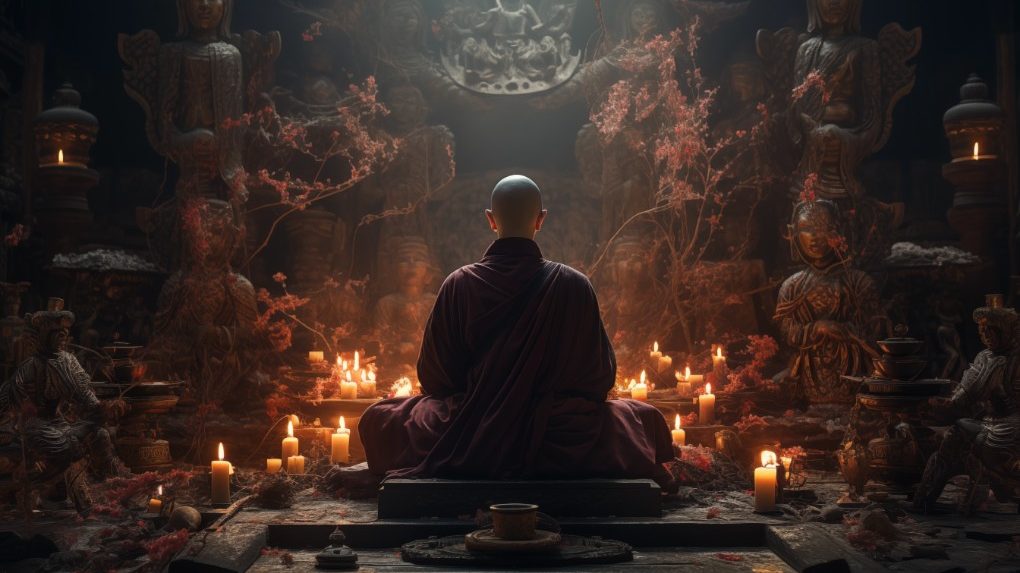The concept of reincarnation is deeply ingrained in many religious traditions around the world. In Buddhism, reincarnation (often interchangeably used with “rebirth”) is a core tenet guiding the beliefs, practices, and aspirations of its followers.
Buddhism Reincarnation: A Deep Dive
The Buddha Taught: Clarifying Reincarnation and Rebirth
Gautama Buddha, the founder of Buddhism, extensively taught about the cycle of birth and death. Contrary to some popular beliefs, what the Buddha taught was not about an immortal soul that moves from one body to another.
Instead, he focused on a process of rebirth—a continuity of consciousness that arises due to causes and conditions. The concept implies that there’s no eternal self or soul (termed as “anatta” or “not self” in Pali) being reincarnated. Instead, it is a stream of consciousness, influenced by past actions or karmas, that gets reborn.
The idea of past lives is intricately linked with the law of karma. Our actions, be they good or bad, have consequences. These consequences might manifest in the present life or in future lives. This perspective makes every action significant, urging Buddhists to pay careful attention to their deeds, thoughts, and words.
In some Buddhist traditions, especially in Tibetan Buddhism, there are practices and meditations specifically designed to recall past life memories. Such memories, though rare, serve as a potent reminder of the long journey each sentient being has undertaken in the cycle of samsara.
Past and Future Lives: The Cycle of Samsara
Samsara, in Buddhist teachings, refers to the cycle of birth, death, and rebirth, driven by desire and ignorance. Sentient beings are caught in this cycle, experiencing various forms of suffering until they achieve liberation or enlightenment.
Every life, whether human, animal, or any other form, is just a transient phase in this vast cycle. Past and future lives are interconnected through a web of actions and their resultant karmas. It’s a causal continuum that emphasizes the interconnectedness of all living beings.
Distinguishing Buddhism from Other Religious Traditions
While reincarnation is also a concept present in other religious traditions, Buddhism’s take on it is unique. Unlike many religions which posit the existence of an immortal soul, Buddhism teaches that what continues from one life to the next is not a soul, but rather a series of mental constructs and energies. This understanding differentiates Buddhism from other religious movements and provides a unique lens through which to view the nature of self, existence, and the ultimate reality.
Related: How Can You Tell if You’ve Been Reincarnated?
Tibetan Buddhism and Reincarnation
Tibetan Buddhism, a branch of Mahayana Buddhism, offers a rich tapestry of teachings on the subject of reincarnation. This tradition, known for its vibrant monastic practices and profound philosophical insights, has deeply embedded beliefs surrounding the cycle of birth and death.
The Significance of the Dalai Lama
In Tibetan Buddhism, the Dalai Lama holds a unique position. He is believed to be the reincarnation of his predecessor, a lineage said to span many lifetimes. The process of identifying the new Dalai Lama involves a series of spiritual and ritualistic steps, including looking for signs and dreams from senior monks.
Once identified, the young Dalai Lama is given rigorous training to prepare him for his role as a spiritual leader. This tradition stands as a testament to the deep belief in reincarnation and the continuity of spiritual lineage.
Several Dalai Lamas have, in the past, demonstrated abilities to recognize people and objects from their previous life. These past life memories serve as reaffirmation for many followers of Tibetan Buddhism in the veracity of reincarnation. Such recognitions are not only limited to the Dalai Lama; many high lamas in the Tibetan tradition have displayed similar abilities.
Reincarnation and the Six Realms: Hellish Beings to Demi Gods
Buddhist teachings discuss six realms of existence where beings can be reborn. These realms, depicted vividly in Tibetan Buddhist thangkas, range from hellish beings, hungry ghosts, and animals to humans, demi gods, and gods. The realm a being is born into is determined by their accumulated karma. Tibetan Buddhism places strong emphasis on practices to ensure a good rebirth and eventual liberation from this cycle.
Practices and Beliefs Specific to Tibetan Buddhism
Apart from the profound belief in reincarnation, Tibetan Buddhism encompasses a myriad of practices aimed at understanding past lives and preparing for future ones. Techniques such as dream yoga, phowa (transference of consciousness at the time of death), and bardo teachings (guidance for the intermediate state between death and rebirth) play a significant role. Additionally, the use of mandalas, mantras, and meditative visualizations assist in the practitioner’s journey through the various stages of life, death, and rebirth.
Theravada Buddhism and the Concept of Rebirth
Theravada Buddhism, prevalent in countries like Sri Lanka, Thailand, and Myanmar, adheres closely to the earliest Buddhist teachings, often referring to the Pali Canon for guidance. This tradition offers a slightly different perspective on reincarnation.
The Pali Canon, a vast collection of early Buddhist texts, provides a wealth of information on the Buddha’s teachings. Within these scriptures, one finds detailed discussions on rebirth. The Buddha, through various discourses, elucidated the intricate processes that lead a being from one life to the next, highlighting the impermanent nature of existence.
In Theravada Buddhism, the emphasis is on the understanding that rebirth is not a transfer of a self or soul, but rather a continuation of a causal process. This process is driven by the three root poisons: ignorance, attachment, and aversion. Until these are uprooted, the cycle continues.
Central to Theravada teachings is the concept of “anatta” or “not self.” This challenges the deeply ingrained belief in a permanent self. Understanding this is pivotal in realizing the true nature of rebirth in the Theravada tradition.
Reincarnation and the Present Life
Our current life is a product of countless previous lives, and simultaneously, it’s a preparatory stage for future existences. In the grand tapestry of samsara, the present life plays a crucial role, serving as both a result and a cause.
The Importance of the Present Moment in Buddhist Practice
Buddhist teachings often stress the significance of the present moment. While understanding past lives and preparing for future ones is important, true transformation occurs in the here and now. The present moment, according to Buddhism, is where past and future converge. By attending to the present with mindfulness and clarity, one shapes the course of their future life.
How Past Lives Shape Our Present Life
Karma accumulated over many lifetimes determines the circumstances of our current existence. Everything from our family, health, to our inclinations can be seen as the ripening of past actions. Past lives leave imprints on our mind, influencing our tendencies, phobias, affinities, and even skills. Some Buddhist traditions even believe that strong connections with other beings in past lives often result in them becoming part of our lives again in some form or another.
Future Lives: Preparing for a Good or Bad Rebirth
Our actions, thoughts, and intentions in the present life will shape the contours of our next existence. A life lived in alignment with the Dharma increases the chances of a favorable rebirth, possibly in the circumstances conducive to spiritual practice. Conversely, negative actions rooted in greed, hatred, and delusion might lead to a less favorable rebirth.
Personal Continuity, the Physical Body, and the Immortal Soul
At the core of the reincarnation debate lies the question of what, if anything, persists beyond death. Does an immortal soul exist? Or is there some other form of continuity?
Buddhism challenges the idea of an eternal, unchanging soul. Instead, it presents the idea of a continuum—a flow of consciousness that moves from one life to the next. This flow is not a static entity but is continually changing, driven by karma and afflictions.
Physical actions, along with mental ones, play a role in determining the trajectory of one’s future rebirth. Every physical event, be it an act of generosity, a harmful deed, or even a simple gesture, leaves karmic imprints. These imprints, when conditions are ripe, manifest in future lives.
While various Buddhist philosophical schools might debate the nuances of reincarnation, the vast majority of Buddhists accept it as a given. For many, it’s an intuitive understanding, arising from both teachings and personal reflections, that life doesn’t begin with birth or end with death. This cyclical view of existence influences the ethical and spiritual choices they make.
The Process of Rebirth: An In-depth Examination
Rebirth is not a random process. It’s governed by a complex interplay of factors that determine the circumstances and realm of one’s next birth.
The primary driving forces behind rebirth are karma and afflictions. Every action, be it physical, verbal, or mental, creates a potential that can, under the right conditions, give rise to a new life. This is often illustrated by the example of planting seeds: the type of seed (action) and the quality of soil (mind’s state) determine the plant’s nature (next life).
While past karma plays a significant role, the moment of death is particularly crucial in determining the next life. The thoughts, emotions, and states of mind at this juncture can influence the trajectory of rebirth. It’s for this reason that many Buddhist practices focus on cultivating positive states of mind, especially towards the end of one’s life.
While understanding and navigating the rebirth process is essential, the ultimate aim of Buddhist practice is to break free from this cycle entirely. By uprooting the causes of rebirth—ignorance, craving, and aversion—one can achieve liberation, a state of unconditioned peace and freedom.
Also read Reincarnation 101: An Introduction
Buddhist Philosophical Schools and Their Take on Reincarnation
Within the vast tradition of Buddhism, reincarnation stands as a central pillar. However, just as there are numerous Buddhist philosophical schools, so too are there diverse interpretations of reincarnation.
Diverging Views and Common Threads in Buddhist Thought
Across the myriad of Buddhist traditions, the concept of reincarnation has undergone various interpretations. While there’s a shared acceptance that human beings undergo multiple births, the mechanics, implications, and finer details often diverge based on the specific teachings and historical contexts of each school. However, one common thread binds them: the emphasis on the causal continuum, with present actions influencing future lives.
In Theravada Buddhism, which strictly adheres to the teachings of the Pali Canon, the emphasis is on “anatta” or “not self.” Here, reincarnation is seen not as an immortal soul’s journey from one body to another, but a continuity of a causal process with past actions influencing future circumstances.
Mahayana Buddhism, with its many sub-schools and interpretations, often introduces more metaphysical concepts. The entire universal process is seen as interdependent, and reincarnation is viewed within this vast web of interconnected phenomena. Here, the emphasis often shifts to the sentient being’s inherent Buddha-nature and the potential for enlightenment in any life.
Vajrayana, or Tibetan Buddhism, offers detailed teachings on the stages between death and the next life, the “bardo.” The Dalai Lama, as the spiritual leader of Tibetan Buddhists, has shared insights from this tradition with the world, emphasizing both the complexity of the rebirth process and the potential for liberation from it.
How Different Traditions Approach Past and Future Lives
The past and future lives concept is intrinsically tied to the idea of karma in Buddhist teachings. Actions in the present moment, both good and bad, leave imprints that come to fruition in future lives.
In early Buddhist texts, there’s a strong emphasis on the immediate implications of actions. While the idea of past lives and future rebirths is acknowledged, the main focus is on achieving liberation in the present life.
In contrast, the Mahayana tradition, particularly in schools like Pure Land Buddhism, places significant emphasis on attaining a good rebirth in a Buddha realm. Here, the practices are geared towards ensuring a favorable future life where conditions for spiritual practice are optimal.
Tibetan Buddhism, with its detailed teachings on the intermediate state or bardo, provides guidance for the dying to navigate the journey post-death and achieve a good rebirth. The Dalai Lamas, as reincarnate lamas, are believed to have consciously chosen their rebirths to continue their work for the benefit of all living beings.
Spiritual Practice and the Journey of Many Lifetimes
Buddhism teaches that our journey spans not just one life but countless lifetimes. With this perspective, spiritual practice becomes a continuous endeavor to purify one’s mind, accumulate merit, and gradually progress toward enlightenment.
How Spiritual Practice Influences One’s Rebirth Process
In the Buddhist path, the present moment and how one engages with it has far-reaching consequences, extending into future lives. Every action, speech, and thought leaves an imprint or “samskara” on the mind. These imprints, when ripened, determine the conditions of one’s future life.
For instance, consistently engaging in acts of generosity and compassion can lead to a favorable rebirth, where conditions are conducive to furthering one’s spiritual practice. On the other hand, harmful actions driven by greed, hatred, or delusion can result in a bad rebirth, possibly even in one of the hellish beings’ realms or the animal realm.
The Role of Monastic Community in Supporting Reincarnation Beliefs
The monastic community, or Sangha, has played a pivotal role in preserving and transmitting the Buddhist teachings across generations. They not only serve as the custodians of the Dharma but also exemplify the Buddhist path in their daily lives.
The Sangha’s members, by renouncing the worldly life, make a profound commitment to the Buddhist path. Through their rigorous spiritual practice, they often become beacons of inspiration for lay followers. Their dedication serves as a testament to the teachings on rebirth, emphasizing that the efforts of this life will bear fruit in the next.
In addition, some esteemed monks and nuns are believed to have recalled their past life memories, further reinforcing the belief in reincarnation among the Buddhist laity. Their anecdotes serve both as a source of wonder and a reminder of the teachings’ profundity.
Achieve Liberation: The Ultimate Aim of Buddhist Practice
While understanding and preparing for the rebirth process is crucial, the end goal of Buddhist practice is to achieve liberation from this cyclic existence altogether. Attain liberation means breaking free from the endless cycle of birth, death, and rebirth, culminating in Nirvana – the extinguishing of all afflictive tendencies and the realization of the ultimate truth.
You may also like Understanding Karma: A Comprehensive Guide
Miscellaneous Topics on Reincarnation in Buddhism
Reincarnation, while being an ancient concept in Buddhism, also intersects with contemporary discussions, scientific scrutiny, and popular culture.
Reincarnation in Modern Context: Pop Culture and Religious Movements
Today’s globalized world has seen a blending of religious traditions and beliefs. Reincarnation, primarily associated with Eastern religious movements, has found a place in Western pop culture. Movies, books, and TV series often explore the idea of past lives, though not always adhering strictly to the Buddhist concept.
Moreover, other religious movements outside of Buddhism have incorporated or resonated with the idea of reincarnation, showcasing its universal appeal and the human fascination with life, death, and the possibility of a new life.
Past Life Memories: Anecdotes and Scientific Scrutiny
There have been numerous accounts of individuals, including children, recalling details of purported past lives. Such past life memories, especially when they contain verifiable details, have piqued the interest of researchers. While some studies suggest potential evidence supporting these claims, skepticism remains, with alternate explanations rooted in psychological and sociocultural factors.
What Survives Death? The Buddhist Answer
One of the profound questions in Buddhist philosophy is: If there is no permanent self or immortal soul, what exactly undergoes the process of rebirth? Buddhism teaches that while there’s no unchanging entity that transfers from one life to another, there’s a continuity – a stream of consciousness, influenced by karma, that moves from one life to the next, akin to a flame being passed from one candle to another.
Conclusion: The Essence of Reincarnation in Buddhism
The intricate weave of rebirth and reincarnation threads through the vast tapestry of Buddhist thought. From early Buddhist texts to present-day interpretations, this concept remains both a source of philosophical inquiry and practical guidance.
Direct disciples of the Buddha, as recorded in the Pali Canon, bore witness to many instances where the Buddha taught about the implications of actions in past and future lives. These teachings, often delivered in response to questions about suffering and its origins, emphasized the causal nature of existence.
In one notable discourse, the Buddha instructed a direct disciple about the importance of understanding one’s actions’ repercussions, not just in this present life but in many lifetimes to come. By recognizing the vast majority of our experiences as consequences of past actions, and the potential for future rebirth based on present actions, the Buddha highlighted the importance of right understanding and right conduct.
For many who tread the Buddhist path, the concept of reincarnation is not just a metaphysical idea but a tool for introspection. By considering the possibilities of past and future lives, individuals are prompted to pay careful attention to their actions, attitudes, and aspirations in the present moment.
Reflecting on reincarnation encourages a broader perspective. It challenges individuals to think beyond the immediacies of this life, fostering a sense of responsibility for one’s spiritual growth. The idea that one’s actions can determine future rebirths instills a profound sense of moral and ethical commitment.
Moreover, by understanding that not everything experienced in this life is a result of present actions, Buddhists cultivate a sense of patience and equanimity. The realization that certain experiences may stem from causes set in motion in previous lives offers a nuanced understanding of suffering and its cessation.
Reincarnation, as understood in Buddhism, is a rich and multifaceted concept. It challenges simplistic notions of self, existence, and time. While various Buddhist traditions might offer different nuances on the subject, the core teachings emphasize personal continuity across lifetimes, the causal nature of existence, and the potential for liberation.
Far from being a mere esoteric doctrine, the teachings on reincarnation have practical implications. They inspire Buddhists to live ethically, to cultivate compassion for all sentient beings, and to diligently pursue the enlightened state. As with all Buddhist teachings, the essence lies not just in intellectual understanding but in direct experience and realization.



